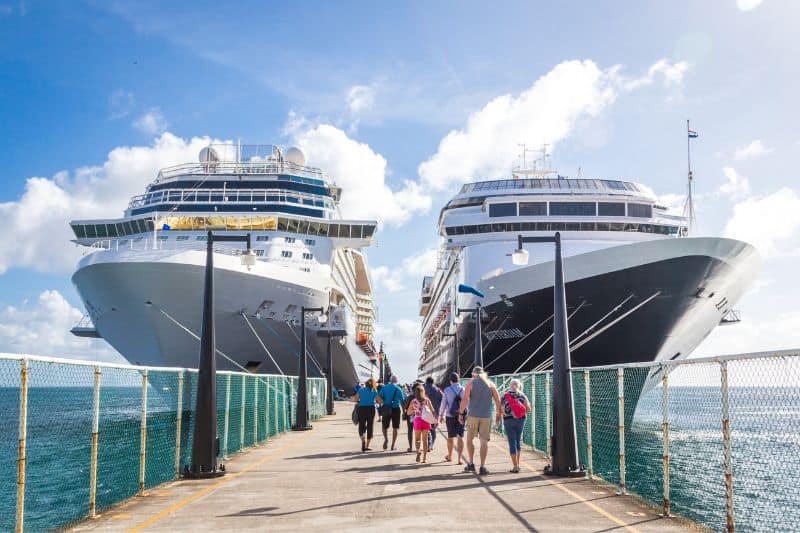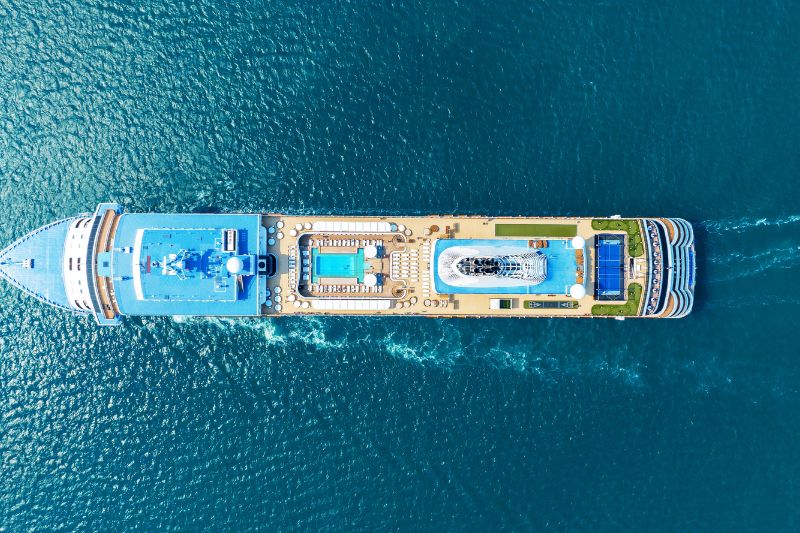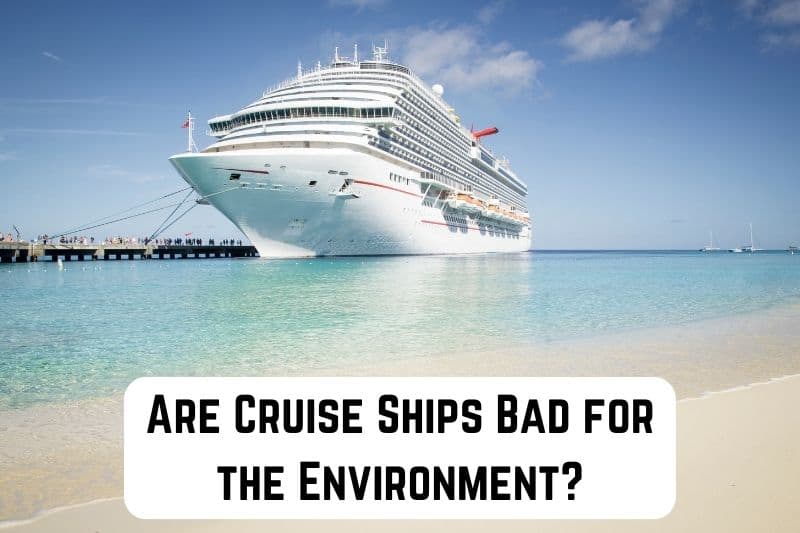Millions of people take to the seas every year aboard cruise ships, seeking a luxurious and relaxing vacation.
However, as tourism continues to grow in popularity, cruise ships have come under scrutiny for their environmental impact on the very waters they navigate.
Are these 1000-foot marine juggernauts truly as harmful to the ocean and its inhabitants as some claim?
Well, that’s what we’re here to discover. In this blog post, we take a deep dive into the environmental impact of cruise ships and explore potential solutions for a more sustainable future.
Read: Are Golf Courses Bad for the Environment?
Are Cruise Ships Truly Harmful to the Environment?
Yes, cruise ships do hurt the environment. In fact, we can safely argue that they’re the world’s worst polluters of the environment. The massive size and scale of these vessels alone can cause significant damage to marine ecosystems, both above and below the water’s surface.
To gauge just how environmentally friendly cruise ships are, Friends of the Earth (FOE), a renowned environmental organization, has been rating these ships annually. Their ratings range from A to F and are based on various sustainability factors:
- Water Quality Compliance: This parameter evaluates if the cruise ships comply with Askan water standards. It also assesses whether their scrubbers cause any water pollution.
- Sewage Treatment: This factor takes into account whether these ships have effective sewage treatment facilities and if they avoid dumping waste into the oceans.
- Air Pollution: Here, FOE looks at what fuels cruise ships use and examines if they are low-sulfur fuels that reduce air pollution.
- Environmental Impact: This parameter takes into consideration whether the cruise ships have any negative impact on the local environment, such as destroying coral reefs or disrupting marine life.
- Transparency: Finally, FOE examines how transparent these cruise lines are about their environmental practices and policies.
Once evaluated based on these factors, FOE publishes its findings, what’s usually called the “Cruise Ship Report Card.”
In the 2022 edition of the report card, this is how the 18 cruise ships scored:
- Grade F – 7 Ships
- Grade D- – 4 Ships
- Grade D – 2 Ships
- Grade D+ – 1 Ship
- Grade C- – 2 Ships
- Grade C – 1 Ship
- Grade C+ – 1 Ship
As you can see, most cruise ships scored an F, which is not surprising considering their negative environmental impact. However, there are a few exceptions, with some ships scoring higher grades due to their efforts towards sustainability.
But why do these large and luxurious cruise ships have such a detrimental impact on the environment? The answer lies in their sheer size and the activities that take place onboard.
Imagine a 1000-foot vessel carrying over 3000 passengers on board. 1000 feet is the size of three and a third football fields, and 3000 passengers is equivalent to a small town, which is why Cruise ships are sometimes known as the floating cities!
So, just how does this floating city impact the environment? Well, let’s take a look at that!

Environmental Impact of Cruise Ships
Did you know that cruise ships can have a significant negative impact on the environment? Despite being marketed as a luxurious way to travel, there are several ways in which these massive vessels contribute to pollution and damage our marine ecosystems.
In the section below, we will examine how these ships cause air, sewage, solid, and other forms of pollution.
1. Air Pollution
Air pollution refers to the introduction of harmful substances into the Earth’s atmosphere. One of the main contributors to air pollution from cruise ships is the fuel burned for movement.
As this ship burns fuel to navigate the waters, it releases greenhouse gasses. These are gasses can come in the form of sulfur oxides, carbon oxides, or other forms, all of which damaging to the environment.
In addition, cruise ship engines are susceptible to leaks, releasing methane into the atmosphere. Now, methane is over 80 times more potent than carbon (iv) oxide when it comes to trapping heat in the atmosphere, again adding to the problem of global warming.
P&O’s MS Iona, for example, emitted as much methane as 10,500 cows over a year. That’s a lot, considering the rising number of cruise ships taking to the seas every year.
2. Sewage Pollution
Besides air pollution, cruise ships are also major contributors to water pollution. With thousands of passengers and crew members, these ships produce vast amounts of sewage daily.
To bring you to perspective, an average 3000-passenger cruise ship produces 21,000 gallons of sewage per day. That’s an enormous amount.
And while these cruise ships are allowed to treat their waste, not most of them have effective treatment mechanisms, so more often than not, sewage waste ends up in the ocean.
When released into the sea, raw or partially treated sewage can cause significant damage to marine life and ecosystems. It can also contaminate beaches and other areas where people swim or engage in water activities.
3. Solid Waste Pollution
Did you know an average 3000-passenger ship can produce 50 tons of solid waste weekly? That’s more waste than a small town produces in the same period.
This solid waste includes everything from food scraps, plastics, and paper products, to even medical waste. In some cases, this waste is incinerated, causing air pollution, while in others, it is illegally dumped into the ocean, affecting marine life.
In addition to harming marine life, solid waste pollution can significantly impact coastal communities and their livelihoods. Many of these communities rely on the fishing and tourism industries for their income, both of which can be severely affected by pollution from cruise ships.
4. Noise Pollution
The effect of cruise ships on the environment is not just limited to air, water, and solid waste pollution. These ships also contribute to noise pollution in the ocean.
The sound of engines, thrusters, and other machinery can penetrate deep down to the bottom of the ocean, disrupting the natural communication and behavior patterns of marine animals like whales and dolphins. This can lead to disorientation, stress, and even death for many marine species.
Moreover, noise pollution from cruise ships can also harm the balance of marine ecosystems. It can interfere with the ability of marine animals to hunt, find mates, and navigate, ultimately affecting their survival and the ocean’s overall health.
5. Chemical Pollution
Cruise ships are also responsible for chemical pollution in the ocean. These ships use a variety of chemicals for cleaning, maintenance, and on-board activities.
When these chemicals are used or disposed of improperly, they can end up in the ocean, causing harm to marine life and posing a threat to human health. Many of these chemicals are toxic and can accumulate in the bodies of marine animals, leading to widespread contamination.
According to a study published in the Journal of Survey in Fisheries Sciences, sulfur compound emissions and spills can lead to reduced oxygen levels in the water, harming fish and other aquatic organisms.
So, as you can see, cruise ships contribute not only to the physical and visual pollution of the ocean but also to its chemical and noise pollution.
In fact, they’ve even been shown to even affect coral reefs, one of the most diverse and vital ecosystems in the world. Cruise ships often anchor directly on top of coral reefs, causing damage to their delicate structures and killing off marine life that depend on them for survival.
For instance, in 2017, a British-owned cruise ship crashed into a coral reef, damaging approximately 13,500 square meters of coral reef in Indonesia. Imagine the devastating impact this has on the marine life that depended on that reef for shelter and food.

Mitigating the Negative Impact of Cruise Ships
Although the negative impacts of cruise ships on the ocean are concerning, there are ways to mitigate their effects.
Let’s look at some of the strategies that can be implemented to reduce the environmental impact of cruise ships.
1. Alternative Fuels and Emissions Control
One way to reduce the pollution caused by cruise ships is to shift towards using alternative fuels such as liquefied natural gas (LNG) or cleaner diesel fuels. These fuels emit fewer sulfur compounds and particulate matter, reducing air and water pollution.
Additionally, implementing emissions control technologies can help reduce the harmful emissions from cruise ships.
2. Waste Management
Proper waste management is crucial on cruise ships to prevent ocean pollution. This includes proper disposal and treatment of sewage, greywater, and solid waste.
Some cruise lines have already implemented advanced wastewater treatment systems that filter out pollutants before releasing the water into the ocean.
Also, recycling and reducing waste produced on board can significantly reduce the environmental impact.
3. Responsible Shore Excursions
Cruise ships often offer shore excursions to their passengers, which can significantly impact local ecosystems and communities if not managed properly.
To mitigate this, cruise lines can work with local organizations and communities to offer responsible and sustainable activities.
These activities include beach clean-ups, wildlife conservation projects, and supporting local businesses promoting eco-friendly practices.
4. Energy Efficiency
Cruise ships are known for their lavish amenities and extravagant designs, but these features consume a lot of energy.
By implementing energy-efficient technologies such as LED lighting, smart heating and cooling systems, and alternative power sources like solar panels, cruise ships can reduce their carbon footprint.
Moreover, educating passengers on energy-saving practices such as turning off lights and air conditioning when leaving their cabins, can also reduce energy consumption.
5. Collaboration with Environmental Organizations
Cruise lines can also collaborate with environmental organizations to further promote sustainability in the industry.
These partnerships can include funding research and conservation projects, participating in clean-up initiatives, and implementing best practices recommended by environmental experts.
Read: How to Dispose of Styrofoam Sustainably?
Alternatives to Cruise Ships
While cruise ships offer a unique and luxurious way of traveling, there are also alternative options available for those who want to experience the beauty of the ocean while being mindful of their environmental impact.
Some alternatives to traditional cruise ships include:
- Expedition Cruises: These smaller ships focus on exploring remote destinations with a strong emphasis on sustainable practices.
- Sailing Yachts: Sailing yachts use wind power instead of fuel, making them a more environmentally friendly option.
- River Cruises: River cruises have a smaller environmental footprint as they mainly operate in inland waterways and use less energy overall.
- Volunteer Vacations: These trips combine traveling with volunteer work, allowing individuals to contribute to conservation efforts while experiencing new cultures.
- Solar-Powered Boats: Similar to sailing yachts, solar-powered boats use renewable energy and have a minimal environmental impact.
In addition to these alternatives, individuals can consider offsetting their carbon footprint by purchasing carbon credits or supporting eco-friendly initiatives when traveling.
Overall, it is important for both the cruise industry and consumers to prioritize sustainability to protect our planet’s oceans for future generations.
By choosing more environmentally friendly options and supporting conservation efforts, we can all positively impact the environment while still enjoying the beauty of the ocean.
So next time you plan a trip, consider these alternatives and consciously decide to protect our oceans. So, it’s up to us to prioritize sustainability in our travel choices and positively impact the environment.






